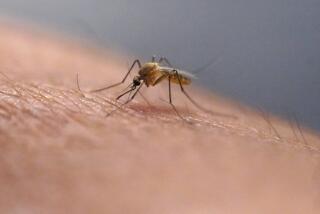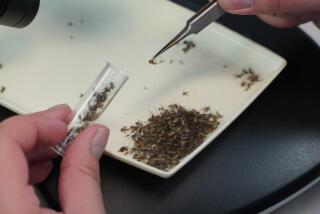‘Thumbs Up’ for a West Nile Test of Blood
- Share via
Tests begun in 2003 to detect West Nile virus in donated blood have drastically reduced the chance of becoming infected via a transfusion, according to two studies published today in the New England Journal of Medicine.
The virus was found in one of every 26,200 blood donations. Screening of “mini-pools,” which combines blood from 16 donors into a single sample, is estimated to catch 93% of infected donations, the researchers said.
The risk of transfusion with blood that is infected but not detected is estimated as less than 1 in 350,000, they said.
Because only a small amount of the virus is required to produce an infection, the mini-pool screening missed the virus in about one-third to one-half of infected blood donations. But follow-up testing showed that at least 85% of the contaminated donations that eluded detection also contained antibodies that neutralize the virus and prevent infection, leaving 7% of donations capable of spreading the disease.
Although the exact number of infections that occurred via transfusions is unknown, experts believe there have been several hundred. The federal Centers for Disease Control and Prevention reported 23 West Nile virus infections from transfusions in 2002, six cases in 2003 and one last year.
So far this year, 35 West Nile-positive donors have been identified and their blood removed from the system.
Dr. Lyle R. Petersen, an expert at the National Center for Infectious Diseases, estimated that the screening program has prevented about 1,500 infections since its introduction in 2003.
“We can give it a unanimous thumbs up,” Petersen said of the screening mechanism.
About 4.5 million Americans receive blood products annually.
West Nile Virus was first identified in the United States in New York City in 1999. The screening program was implemented after the virus was first shown to be transmissible via blood transfusion in the summer of 2002.
“West Nile Virus was on nobody’s radar screen as a disease threat before 1999,” said Petersen, who summarized the nation’s screening programs in an editorial that accompanies the journal studies. “Nobody even considered a threat to the blood supply when it first came to light.”
West Nile Virus is most commonly transmitted to humans from mosquitoes that had previously fed upon infected birds. About 80% of infected people show no symptoms of the infection.
The rest suffer flu-like symptoms such as fever and nausea for several weeks. Fewer than 1%, primarily the elderly and others with compromised immune systems, experience severe neurological damage or die, according to the CDC.
The toll from West Nile virus may be getting worse. The virus infected 2,448 people in the U.S. last year, killing 84, the CDC said. In California, 830 infections, including 66 detected during blood donation, resulted in 27 deaths in 2004, according to state health officials. There have been 64 cases, and two deaths, reported in the state this year, though the peak transmission season is from late summer to early fall.
“Compared to last year, we’ve seen fewer cases,” said Ben Sun, a veterinarian with the California Department of Health Services. “We expect a lot more activity this year in Central and Northern California.”
In 2004, 52% of the nation’s 104 infected blood donations were found in Los Angeles, Orange, Riverside and San Bernardino counties. The rate of one infection per 1,566 donations in these four counties was 16 times the national rate.
More to Read
Sign up for Essential California
The most important California stories and recommendations in your inbox every morning.
You may occasionally receive promotional content from the Los Angeles Times.













